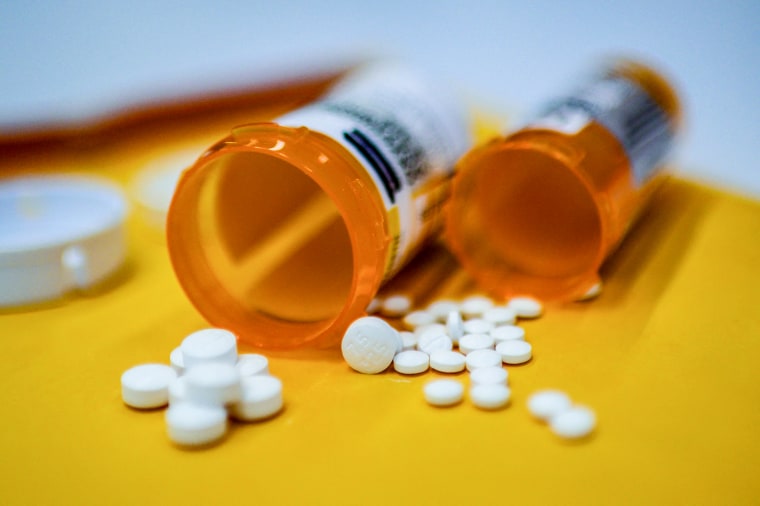Opioids were the most common substance contributing to the poisoning deaths of children ages 5 and younger, according to a new study.
The research, published Wednesday in the journal Pediatrics, found that opioids accounted for more than 47% of the poisoning deaths among children in that age group between 2005 and 2018 — 346 of 731 total deaths reported to the National Center for Fatality Review and Prevention.
Meanwhile, over-the-counter pain, cold and allergy medications contributed to a little less than 15% of the deaths.
The sobering findings underscore the extent of the opioid epidemic’s impact on children, according to Dr. Christopher Gaw, the study’s lead author.
“Opioids are implicated in so many deaths, and there are hundreds or thousands of potentially dangerous substances for children in our environment, but we’re really seeing that one stand out,” said Gaw, a pediatric emergency medicine fellow at the Children’s Hospital of Philadelphia.
The study did not offer a breakdown between opioids children were exposed to in the form of prescription drugs versus illegal drugs like heroin.
Overall, fatal poisonings among children have decreased since the 1970 passage of the Poison Prevention Packaging Act, which requires child-resistant packaging on potentially hazardous substances such as aspirin or mouthwash. But opioids accounted for a growing share of the substances responsible for poisonings between 2005 and 2018: Whereas 24% of the various substances that killed children in 2005 were opioids, they made up 52% in 2018.
The increase tracks with overdose trends among adults over the same time frame. Data from the Centers for Disease Control and Prevention shows that opioid overdoses killed roughly 21 out of every 100,000 people in 2020, compared to 5 out of every 100,000 in 2005.
In total, more than 564,000 people died from opioid-involved overdoses between 1999 and 2020, according to the CDC.
"If we're seeing more nonprescription opioids in our communities, then children are always at risk of being exposed to those," Gaw said.
Indeed, fentanyl deaths in young children due to accidental exposure have been on the rise in recent years. In one notable case, the family of a 19-month-old who died after being exposed to fentanyl has sued Airbnb, alleging that the infant's exposure happened at a rental property in Florida listed on the platform.
Most of the poisoning deaths analyzed in the new study occurred in infants. White children accounted for nearly 44% of the deaths in which race was documented, Black children made up nearly 33%, and Hispanic children accounted for 17%. Infants of other races made up 6%, though the study only listed data for that group through age 1.
The majority of deaths occurred at home and while the children were being supervised by a biological parent, the study found.
But among cases in which information about the child's supervision was recorded, someone other than their biological parent was watching the child 32% of the time. The study authors emphasized the importance of educating nonparental caregivers about poisoning prevention.
Parents, caregivers and anyone else who keeps opioids — or other potentially toxic substances — in a home where children live or visit should keep them "out of reach, out of sight, out of mind, preferably behind a closed and locked cabinet," Gaw said.
Signs of opioid poisoning in young children include slow and shallow breathing, contracted pupils and appearing unresponsive or limp, Gaw said.
He added that health care providers should remember that pediatric opioid poisonings happen and can be very dangerous and potentially fatal.
Anyone who spends time with kids should also be aware that naloxone "is an antidote that is effective, safe and potentially lifesaving for even the youngest of children," Gaw said.
Naloxone, also sold under the brand name Narcan, is available via prescription, but many states allow certain consumers to obtain it from a pharmacist without a prescription for themselves or someone else who may be at risk of an overdose, according to the Food and Drug Administration.
“Every death from opioids is a tragedy, as is every death of a young child. If opioids are going to be in the home, everyone in the home should be trained on how to recognize an opioid overdose and have naloxone so they are ready to save a life,” said Mike Selick, associate director of capacity building for the National Harm Reduction Coalition.
An FDA advisory committee recommended last month that a nasal spray version of naloxone be sold over the counter. The agency is expected to make a decision by March 29; if that version is approved, the medication could then be sold in convenience stores, grocery stores and vending machines.
Gaw noted a limitation of his study: Just 40 states log information about child and fetal deaths in the National Fatality Review Case Reporting System, and even then, the information in the database varies based on their capacities to conduct inquiries into the circumstances surrounding a child's death.
So the actual number of fatal opioid poisonings is likely higher, he said.
